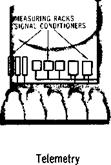Instrumentation System
The first stage instrumentation system measures and reports information on stage systems and components and provides data on internal and external environments. It keeps abreast of approximately 900 measurements on the stage, such as measurements of valve positions, propellant levels, temperatures, voltages, and pressures. The measurements are telemetered by coaxial cable to ground support equipment and by radio frequency transmission to ground stations.
The instrumentation system consists of a measurement system, a telemetry system, and the Offset Doppler tracking system. A remote automatic calibration system provides remote rapid checkout of the measurements and telemetry systems.
MEASUREMENT
The measurement system reports environmental situations and how the first stage reacts to them. Making use of transducers, signal conditioners, measuring rack assemblies, measuring distributors, and the onboard portion of the remote automatic calibration system, this system involves many phases of stage operation. Included are measurements of acceleration, acoustics, current, flow, flight
 TELEMETRY
TELEMETRY
Telemetry is a method of remote monitoring of flight information accomplished by means of a radio link. The first stage telemetry system is composed of six radio frequency links.
Most of the components of the telemetry systems are located in the thrust structure; RF assemblies and a tape recorder are located in the forward skirt. The telemeter transmits data through two common antenna systems.
Links FI, F2, and F3 are identical systems which transmit narrow-band, frequency-type data such as that generated by strain gages, temperature gages, and pressure gages. The system can handle 234 measurements on a time-sharing basis and 14 measurements transmitted continously. Data may be sampled either 120 times per second or 12 times per second.
|
ANTENNAS TRANSMITTERS ; TAPE RECORDER R F COMPONENTS
|
Links SI and S2 transmit wide-band, frequency – type data generated by vibration sensors. Each link provides 15 continuous channels or a maximum of 75 multiplexed channels depending on the specific measuring program.
Telemeter PI transmits cither pulse code modulated or digital type data. Five multiplexers, four analogs, and one digital supply data to the PCM assembly. This provides the most accurate data and is used for ground checkout as well.
A telemetering calibrator is used to improve the accuracy of the telemetry systems. The calibrator supplies known voltages to the telemeters periodi
cally during the stage operation. Their reception at tracking stations provides a valid reference for data reduction.
The effects of ullage and retrorocket firing attenuation can seriously degrade the telemetry transmission during stage separation; therefore, a tape recorder installed in the forward skirt records data for delayed transmission. The commands for tape recorder operation originate in the digital computer located in the instrument unit.
ODOP SYSTEM (Offset Doppler Tracking System)
The ODOP system is an elliptical tracking system that measures the rate of motion at which the vehicle is moving away from or toward a tracking station. The total Doppler shift in the frequency of a continuous wave, ultra-high frequency signal transmitted from the ground to the first stage is measured. The signal is received by the transponder at the stage, modified, and then retransmitted back to the ground. Retransmitted signals are received simultaneously by three tracking stations. Separate antennas on the stage are used for receiving and retransmitting the signals.











